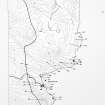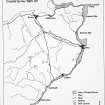Scheduled Maintenance
Please be advised that this website will undergo scheduled maintenance on the following dates: •
Tuesday 3rd December 11:00-15:00
During these times, some services may be temporarily unavailable. We apologise for any inconvenience this may cause.
Sgarbach, Auckingill
Long Cairn (Neolithic)
Site Name Sgarbach, Auckingill
Classification Long Cairn (Neolithic)
Alternative Name(s) Can 083
Canmore ID 9324
Site Number ND36SE 25
NGR ND 3731 6393
Datum OSGB36 - NGR
Permalink http://canmore.org.uk/site/9324
- Council Highland
- Parish Canisbay
- Former Region Highland
- Former District Caithness
- Former County Caithness
ND36SE 25 3731 6393.
A mutilated, amorphous mound containing several large, flat slabs one
of which bears
the date 1928.
Visited by OS 10 September 1965.
A possible horned cairn, 60m N-S by 18m. Nicholson excavated between the horns in 1928.
C E Batey 1982.
Situated on a low ridge sloping gradually down to the NE, are the denuded remains of a long horned cairn, overgrown with heather and rough grass. It measures 60.0m NE-SW along the ridge, 14.0m wide and 0.3m high at the NE end, narrowing to a 'waist' 12.0m wide, and expanding to a width of 18.0m and a height of 0.6m at the highest point in the SW, though there is evidence of quarrying and displacement of cairn material in the SW. There is no evidence of horns in the NE, but in the SW are the vague truncated remains of two. Midway between the horns in the body of the cairn is Nicholson's excavation pit with a loose, displaced slab, possibly a lintel, alongside. In the sides of two land drains which cross the cairn can be seen a content of earth and stone, with a higher ratio of stone than is evident in the vicinty.
There is no local knowledge of any finds having been made.
Surveyed at 1:2500
Visited by OS 22 July 1982.
The last remains of this cairn are at 20m OD, 90m from the cliffs in a small area of moorland between the flat cultivated land and the sea.
The cairn is overgrown with coarse grass and heather. It is 61m long, the axis lying NNE to SSW. The N part, for about 44m from the N end, has been reduced to little more than a bank of cairn material 0.3m high defining each long side. Near the N end the cairn is 10 to 11m wide, expanding very slightly towards the S. The edges of this part of the cairn are rather indefinite. At about 10m from the N end it is cut by a fence and ditch; in the side of the latter a few pieces of shattered stone can be seen, and at the W edge of the cairn two small slabs one above the other are possibly part of a wall-face.
At about 15.5m from the S end the cairn widens asymmetrically to give a maximum width of about 19m. There is more cairn material in the S part of the cairn, the maximum height near the SW and SE sides being 0.8m, and the edge is fairly clear. On the W side, after disturbance, the edge bends to the SW and forms a right-angled SW corner. On the E side the edge bulges sharply then curves westwards to give a gently convex plan to the S end of the cairn. At the N end of the bulge the curve of the E edge continues westwards across the cairn as a low arc of cairn material fading away on the line of the axis 16.5m from the S end. The centre of the S part of the cairn has been greatly robbed, and somewhat SW of the centre is a deep oval hollow with upcast beside it, made during brief investigations by J Nicolson in 1928 (Batey supra). On its W side is a half-hidden prone slab 1.35m long.
Though extremely ruined, the remains give the impression that a low long cairn with an expanded and somewhat higher S part, its S edge almost straight in plan, has been overlaid at the S end by a round cairn placed to the E of the axis.
Visited 1 July 1988.
J L Davidson and A S Henshall 1991.
Field Visit (10 September 1965)
A mutilated, amorphous mound containing several large, flat slabs one
of which bears
the date 1928.
Visited by OS 10 September 1965.
Project (1980 - 1982)
Field Visit (22 July 1982)
Situated on a low ridge sloping gradually down to the NE, are the denuded remains of a long horned cairn, overgrown with heather and rough grass. It measures 60.0m NE-SW along the ridge, 14.0m wide and 0.3m high at the NE end, narrowing to a 'waist' 12.0m wide, and expanding to a width of 18.0m and a height of 0.6m at the highest point in the SW, though there is evidence of quarrying and displacement of cairn material in the SW. There is no evidence of horns in the NE, but in the SW are the vague truncated remains of two. Midway between the horns in the body of the cairn is Nicholson's excavation pit with a loose, displaced slab, possibly a lintel, alongside. In the sides of two land drains which cross the cairn can be seen a content of earth and stone, with a higher ratio of stone than is evident in the vicinty.
There is no local knowledge of any finds having been made.
Surveyed at 1:2500
Visited by OS 22 July 1982.
Field Visit (1982)
A possible horned cairn, 60m N-S by 18m. Nicholson excavated between the horns in 1928.
C E Batey 1982.
Field Visit (1 July 1988)
The last remains of this cairn are at 20m OD, 90m from the cliffs in a small area of moorland between the flat cultivated land and the sea.
The cairn is overgrown with coarse grass and heather. It is 61m long, the axis lying NNE to SSW. The N part, for about 44m from the N end, has been reduced to little more than a bank of cairn material 0.3m high defining each long side. Near the N end the cairn is 10 to 11m wide, expanding very slightly towards the S. The edges of this part of the cairn are rather indefinite. At about 10m from the N end it is cut by a fence and ditch; in the side of the latter a few pieces of shattered stone can be seen, and at the W edge of the cairn two small slabs one above the other are possibly part of a wall-face.
At about 15.5m from the S end the cairn widens asymmetrically to give a maximum width of about 19m. There is more cairn material in the S part of the cairn, the maximum height near the SW and SE sides being 0.8m, and the edge is fairly clear. On the W side, after disturbance, the edge bends to the SW and forms a right-angled SW corner. On the E side the edge bulges sharply then curves westwards to give a gently convex plan to the S end of the cairn. At the N end of the bulge the curve of the E edge continues westwards across the cairn as a low arc of cairn material fading away on the line of the axis 16.5m from the S end. The centre of the S part of the cairn has been greatly robbed, and somewhat SW of the centre is a deep oval hollow with upcast beside it, made during brief investigations by J Nicolson in 1928 (Batey supra). On its W side is a half-hidden prone slab 1.35m long.
Though extremely ruined, the remains give the impression that a low long cairn with an expanded and somewhat higher S part, its S edge almost straight in plan, has been overlaid at the S end by a round cairn placed to the E of the axis.
Visited 1 July 1988.
J L Davidson and A S Henshall 1991.
































